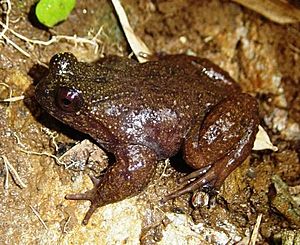Barrio's frog facts for kids
Quick facts for kids Barrio's frog |
|
|---|---|
 |
|
| Conservation status | |
| Scientific classification |
Insuetophrynus acarpicus is a special kind of frog known as Barrio's frog. It's the only species in its group, called Insuetophrynus. This unique frog belongs to the Rhinodermatidae family.
Barrio's frog lives only in Chile, which means it's endemic there. You can find it in just a few places along the Valdivian Coast Range. These areas include Chanchán in the Los Ríos Region and Queule in the Araucanía Region. It lives at elevations from about 50 to 486 meters above sea level.
Contents
What does Barrio's Frog look like?
Adult male Barrio's frogs are usually about 41 to 56 millimeters long. Female frogs are a bit smaller, measuring 35 to 53 millimeters. These frogs have strong bodies with powerful arms and legs, making them excellent jumpers!
Their toes are partly webbed, but their fingers are short and thick without webbing. The frog's head is wider than it is long, with a broad, rounded snout. They have large eyes, and you can see their eardrum (called a tympanum), though it's not very big.
The back of Barrio's frog is a reddish-brown color with some small, whitish bumps. Their hind legs often have darker stripes. The throat is a pinkish-yellow, and the stomach is pale. Their skin is quite bumpy or warty on the back and stomach, but the throat is fairly smooth.
Where does Barrio's Frog live?
Insuetophrynus acarpicus makes its home near streams along the coast in cool, wet forests. During the day, adult frogs like to hide under stones to stay safe. When night comes, they come out to find food along the edges of the streams.
Young frogs, called Tadpoles, can be found hiding under stones in muddy areas where the water doesn't flow too fast.
Protecting Barrio's Frog
Barrio's frog lives in a very small area, only about 33 kilometers along the coast. Its home is in danger because of activities like clear-cutting (when all trees are cut down) and afforestation (planting new trees, but sometimes with non-native species that change the habitat). These activities can harm the frog's natural environment.
Scientists and conservationists are working to protect this special frog and its unique habitat in Chile.[[Category:Amphibians ]]
See also

- In Spanish: Insuetophrynus acarpicus para niños


